Click image for BBB rating
See our Privacy Policy
|
Welcome to Spaightwood Galleries, Inc.
120 Main Street, Upton MA 01568-6193
Alberto Giacometti (Swiss, 1901-1966): Objects, People, and Places
|
|
|
Although Giacometti exhibited with artists of the Surrealist movement during the early 1930s, the style for which he is most known developed later. Acclaimed by many as the most important sculptor of the middle decades of the twentieth century, Giacometti's sculptures, whether small enough to fit into a match box or towering over normal-sized people, expressed the angst of a world that had just experienced the horrors of World War II and was living in dread of a nuclear war. His figures are alienated from each other (and often themselves), existing nervously in a world that might consume them at any moment. In his group sculptures, none of the many figures occupying or crossing a given space ever make eye contact with each other, instead huddling inside themselves in alienated isolation. In the 1950s Giacometti turned with renewed interest to painting and printmaking, and is also considered an artist of great stature in these areas as well as sculpture. In his prints, whether working with a lithographic crayon on stone or a needle in copper, Giacometti created a large body of works featuring people, many of them close acquaintenances: his brother Diego, his wife Annette, his mistress Caroline, his friends, aiming less at a likeness than at a statement of the human condition: people pass through an often hostile world, mostly alone, aging as they go. For Giacometti, flesh, if not grass that fades, is clay that is malleable and changes constantly, pulled and pushed about violently by a sculptor, losing substance and suffering for the loses. His works are to be found in almost every major museum in the world.
Bibliography: General works: Yves Bonnefoy, Giacometti (NY: Abbeville, 1991); Jacques Dupin, Alberto Giacometti (Paris: Maeght, 1963); Patrick Elliott, Alberto Giacometti 1901-1966 (Edinburgh, National Galleries of Scotland, 1996); Valerie J. Fletcher (with essays by Silvio Berthoud and Reinhold Hohl), Alberto Giacometti 1901-1966 (Washington: Hirshhorn Museum and Sculpture Garden, 1988); Reinhold Hohl, Alberto Giacometti (Stuttgart: Gerd Hatje, 1971); James Lord, A Giacometti Portrait (NY: The Museum of Modern Art, 1965); James Lord, Alberto Giacometti Drawings (Greenwich CT: NY Graphic Society, 1971); Peter Selz, Alberto Giacometti (NY: The Museum of Modern Art, 1965); Angela Schneider, ed. Alberto Giacometti: sculpture, paintings, drawings (Prestel, 1994); David Sylvester, Looking at Giacometti (NY: Henry Holt & Co., 1996); Veronique Wiesinger et al., L'Atelier d'Alberto Giacometti: Collection de la Fondation Alberto et Annette Giacometti (Paris: Centre Pompidou, 2007).
Prints: Jean Genet et al. Alberto Giacometti Ouevre Grave (Tarascon: Maeght Editeur, 1990--includes texts in French by Genet, Giacometti, Sartre and Gerard-Georges Lemaire); Herbert Lust, Alberto Giacometti The Complete Graphics and 15 Drawings (NY: Crown, 1970); Chiara Negri, "Giacometti Lithographer and Etcher," Il conoscitore di stampe / print collector, Vol 4, n. 43, (1979), 2-33.
|
|
|
|
|
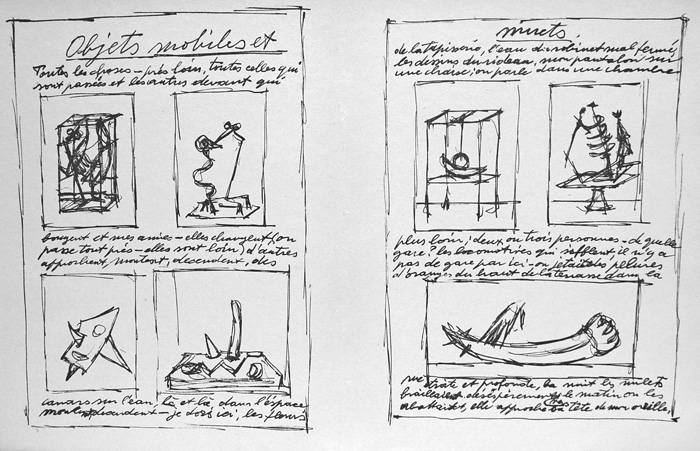 |
|
|
Objets mobiles et muet / Moving mute objects (Lust 1). Original lithograph, 1931. 30 impressions published by the Revue de surrealisme in 1931. In 1951 a second edition (c. 1200 unsigned impressions, of which ours is one) was published in the deluxe art review, XXe Siecle. One of the most important Surrealist prints and Giacometti's first lithograph: a very rare and important work. Illustrated in the Centre Pompidou 2007-2008 exposition, "L'atelier d'Alberto Giacometti," fig. 403. Our impression just back from restoration where it was backed with an archival support sheet to strengthen it at the old centerfold where it was bound into the 1951 XXe Siecle. In this work, Giacometti offers a vision of a new subject matter for artists, silent, somewhat threatening, but mostly inexplicable subjects for art. Hard to find! Image size: 320x470mm. Price: Please call or email for current pricing information.
|
|
|
|
|
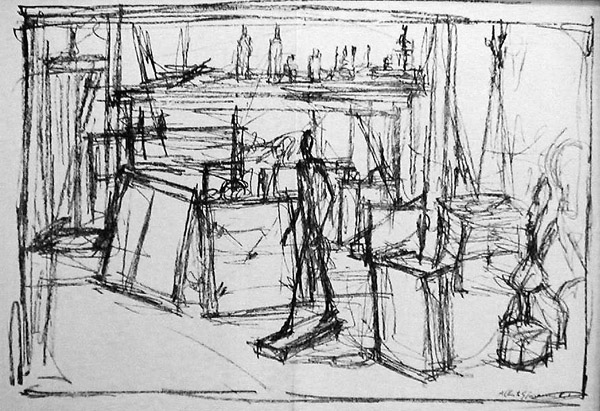 |
|
|
|
"Man Walking" in the Studio (Lust 94). Original lithograph, 1951. Published in the deluxe art review, Derrière le Miroir. Edition unknown (c. 1000 impressions signed in the stone; there are no pencil-signed impressions). One of the casts of "Man Walking" recently set a world record for a sculpture at Please call or email for current pricing information.3 million dollars. While we don't have any Giacometti sculptures, we do have his incredible original lithograph, "Man Walking" in the Studio as wll as over twenty other original lithographs and etchings. With the usual centerfold. The browning is only in the photograph; all images are on uniformly white paper. Image size: 380x560mm. Price: Please call or email for current pricing information.
|
|
|
|
|
|
|
|
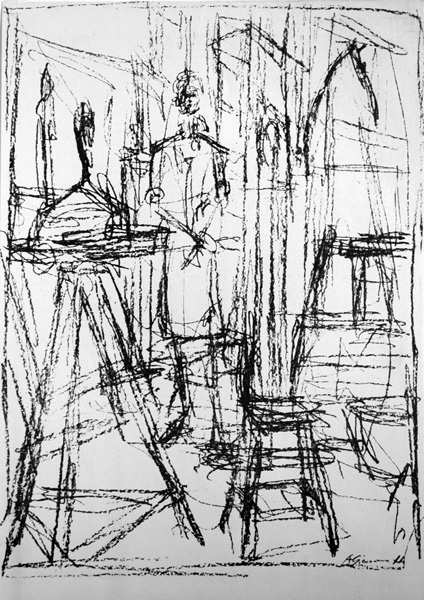 |
|
Annette, Horse, Stool (Lust 92). Original lithograph, 1951. Published in the deluxe art review, Derrière le Miroir. Edition unknown (c. 1000 impressions signed in the stone; there are no pencil-signed impressions.) The browning is only in the photograph; all images are on uniformly white paper. Image size: 380x280mm. Price: Please call or email for current pricing information.
|
|
|
|
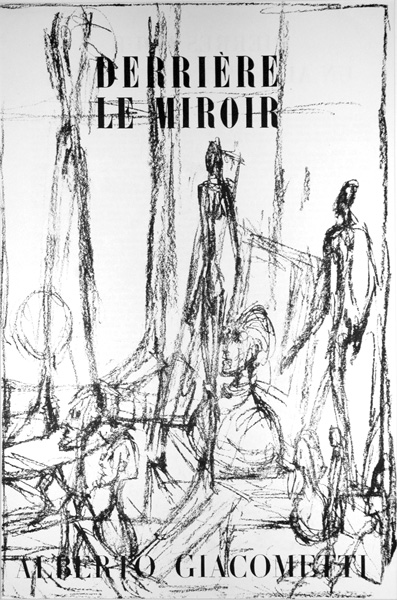 |
|
Standing Statues in the Studio (Lust 93). Original lithograph, 1951. Published in the deluxe art review, Derrière le Miroir. Edition unknown (c. 1000 impressions signed in the stone; there are no pencil-signed impressions.) The browning is only in the photograph; all images are on uniformly white paper. Image size: 380x280mm. Price: Please call or email for current pricing information.
|
|
|
|
|
|
There is a general consensus that three of his very greatest lithographs were published in the 1951 issue of the deluxe art review Derriere le Miroir dedicated to his work. Lust describes his reaction to seeing these works in Giacometti's studio:
Entering Giacometti's studio [in the spring of 1951], which was filled with his finest sculptures, I found the artist peering at some sheets crammed with violent black slashes. The sheet in his hand made me catch my breath. It was a lithograph of the studio [Lust 94; see above] with the statue of the Man Walking cutting across the center. It hit me like a bomb, like a wild primeval explosion in the earth. It was one of the most dramatic works I had ever seen in black and white.
The lithograph turned out to be the centerpiece for the catalogue of the Maeght show, the finest Alberto was ever to have, and one that embraced almost all of his great statues. . . . The catalogue for the show was a text by that austere poet Michel Leiris . . . illustrated by three lithographs [Lust 92-94] by Alberto. Thus, it was at the very height of his creative surge, with all his abilities straining at full stream, with his talents turning more and more toward painting, that Giacometti did his first great lithographs, those at which he was peering that spring day.
Little wonder that, given the fevered circumstances and the ideal situation, Alberto never surpassed these particular lithographs, though in 1954 he equaled them. These first drawings on stone represent the collision of his mature sculptural style with his newly discovered mastery of painting. These four lithographs [including the poster for the show] concern the studio and portray: a group of standing statues and busts with the catalogue's title printed at the top and bottom (93); his wife, sculptures of a horse and other subjects (92); a panoramic view of the studio with the Man Walking in the center (94). (Lust 73-74)
Lust prized these lithographs because he loved Giacometti's sculptures, which even them were beyond the reach of all but the wealthy. As he says to the artist, "Everything you have ever done as an artist is in them. One gets the same feeling from these lithographs as from the actual bronzes" (p. 74). Lust goes on to suggest that "Giacometti looked upon his bronzes as suprahumans. And since in 1951 and 1954 he became an audience to his studio, stood in wonder before his bronzes, at times perhaps not believing he had created them, he became, as he recorded them for history, rather like the chorus in a Greek play in which his statues were the players. For Lust, the wonder of Giacometti's studio lithographs is that "never has a cycle of prints by a major artist been so austere and stark, so devoid of charm and seductions. Giacometti had focused all his efforts on the severe stark architecture of his heart." In these works, Lust concludes, he gives us "the black ecstasy of an imagination that is its own prison" (75).
Chiara Negri, "Giacometti Lithographer and Etcher," singles out the three lithographs for the 1951 Derriere le Miroir and three of the 1954 Studio lithographs (including Annette in the Studio [Lust 10]) as the best examples of his lithographs, "the very keystone of Giacometti's entire output" (2): "All show the studio, cluttered with sculptures, paintings, stools, trestles, chairs and all the tools and tackle of a sculptor. All three [of the 1951 Derriere le Miroir lithographs] include a figure (either a person . . . or a sculpture in the center of the sheet, the pivot of the whole composition. The significance of Annette goes beyond the figures merely formal function (as a balancing element for the whole scene). She . . . is above all else a symbol of the relationship between the artist and his art, i.e. his own works. Giacometti went on to produce an enormous number of other lithographs, possibly technically more successful, but never showing with more clarity the value of graphics as a means of reflection on his own activity, and therefore on his own existence" (11).
Negri does on to discuss the 1954 studio lithographs in terms of their development of this theme, singling out Annette in the studio (Lust 10, which here receives a full-page illustration) and two others. "Everything we have said so far applies equally to the whole cycle of seventeen lithographs made in 1954 (each in an edition of 30) which once more take the artist's studio as their subject. . . . Giacometti was never again to equal the dramatic force achieved in this first 'heroic' period. The power of these works can be appreciated by a glance at Annette dans l'atelier [Lust 10]. . . . The 'theme' of the whole series is basically the same, as is the tense and agitated atmosphere pervading them all from the first to the last. In addition, these three works repeat—amplified, with more pathos, more power— the theme identifies earlier in the three Derriere le Miroir lithographs: the theme of the relationship of man and art" (13-14).
|
|
 |
|
|
|
The Tree. Original color lithograph, 1952. As published in the 1952 issue of the deluxe art review Verve. Giacometti's original lithograph, City Scene, is printed on the reverse (see immediately below). A very vertical person contemplates the even-more pronounced verticality of the tree. This may be Giacometti's only color lithograph; it is certainly one of a very small number if there are others. The Cenre Pompidou's fall-winter 2007 Giacometti exhibition included Giacometti's drawing (in reverse), a trial proof and one of the impressions from Verve. In both of these works, Giacometti moves us outside of the Studio and into a larger world, one in which humans are as dwarfed by nature (note the tiny figure to the left of the giant tree) as they seem to be by the buildings towering over them in the lithograph printed on the reverse (see below). Image size: 353x232mm. Price: Please call or email for current pricing information.
|
|
|
|
|
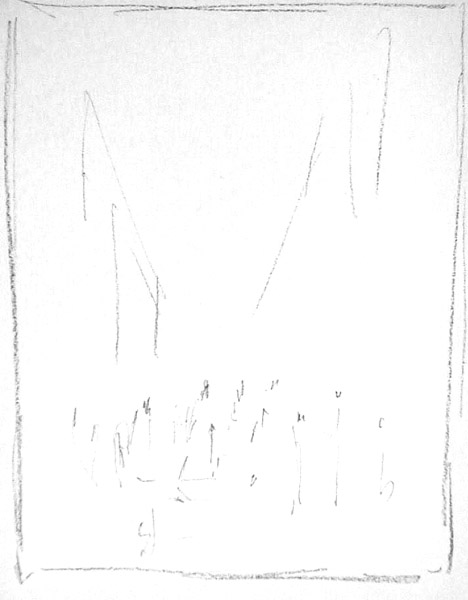 |
|
City Scene. Original lithograph, 1952. As published in the 1952 issue of the deluxe art review Verve. Giacometti's original color lithograph, The Tree, is printed on the reverse (see immediately above). Image size: 353x232mm. Price: Free with the purchase the The Tree (above; or vice versa, Please call or email for current pricing information with The Tree free with the purchase of City Scene for Please call or email for current pricing information.)
|
|
|
|
|
|
 |
|
|
|
Annette facing front (Lust 62). Original etching, 1956. 50 signed and numbered impressions plus c. 1000 unsigned unsigned impressions from the cancelled plate published in the 10th Anniversary issue of the deluxe art review, Derriere le Miroir. Image size: 206x57mm. Price: Please call or email for current pricing information.
|
|
|
|
 |
|
Nude in profile (Lust 64). Original etching, 1955. 50 signed and numbered impressions plus c. 1000 unsigned unsigned impressions from the cancelled plate published in the 10th Anniversary issue of the deluxe art review, Derriere le Miroir. Image size: 304x57mm. Price: Please call or email for current pricing information.
|
|
|
|
 |
|
|
|
The studio with bottles (Lust 100). Original lithograph, 1957. 100 signed and numbered impressions plus an unsigned edition with the usual centerfold. published in 1957 in the deluxe art review, Derrière le Miroir from which our impression comes. The work is illustrated in the second edition of Felix Man's 150 Years of Artists' Lithography. The work is printed in a brownish black ink; the paper is uniformly white. Image size: 380x560mm. Price: Please call or email for current pricing information.
|
|
|
|
|
|
|
|
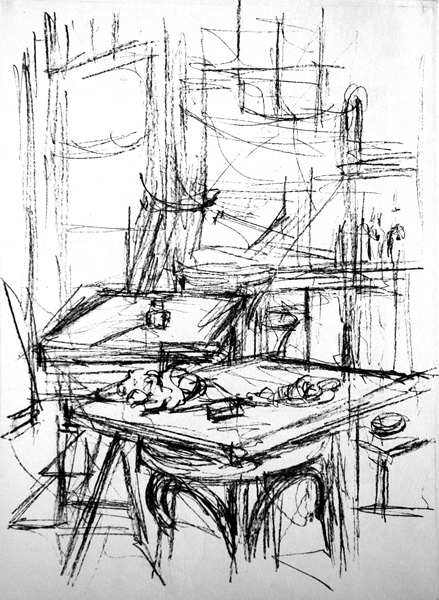 |
|
Drafting tables in the studio (not in Lust; described as an original lithograph in the catalogue raisonné of Derriere le Miroir). Original lithograph, 1957. Published 1957 in the deluxe art review, Derrière le Miroir. Edition unknown (c. 1000 impressions signed in the stone; there are no pencil-signed impressions.) All images are on uniformly white paper. Image size: 380x280mm. Price: Please call or email for current pricing information.
|
|
|
|
|
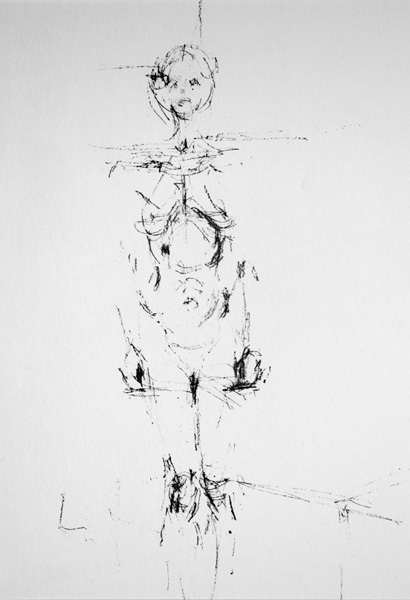 |
|
Woman standing. Original lithograph, 1958. Published in 1958 in a special number of the deluxe art review Derriere le Miroir. A woman, apparently Giacometti's wife Annette, stands slightly off the vertical axis like the leaning tower of Pisa. Image size: 380x280mm. Price: Please call or email for current pricing information.
|
|
|
|
Spaightwood Galleries, Inc.
To purchase, call us at 1-800-809-3343 (1-508-529-2511 in Upton MA & vicinity) or send an email to spaightwood@gmail.com.
We accept AmericanExpress, DiscoverCard, MasterCard, and Visa.
We also accept wire transfers and paypal.
For directions and visiting information, please call. We are, of course, always available over the web and by telephone (see above for contact information). Click the following for links to past shows and artists. For a visual tour of the gallery, please click here. For information about Andy Weiner and Sonja Hansard-Weiner, please click here. For a list of special offers currently available, see Specials.
All works are sold with an unconditional guarantee of authenticity as described on our website.
Go back to the top of this page.
Visiting hours: Saturday 10:00 am to 5:00 pm and Sunday noon to 6:00 pm and other times by arrangement.
Please call to confirm your visit. Browsers and guests are welcome.
|
|
|
|
|
|
|
|
|
|
|
|
|
|
|
|
|
|
|
|
|
|
|
|
|
|
|
|










